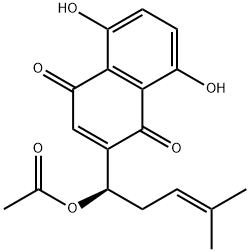ACETYLSHIKONIN
- CAS NO.:24502-78-1
- Empirical Formula: C18H18O6
- Molecular Weight: 330.33
- MDL number: MFCD00143538
- SAFETY DATA SHEET (SDS)
- Update Date: 2024-11-19 15:53:33

What is ACETYLSHIKONIN?
Chemical properties
Acetylshikonin is a biologically active compound with anti-cancer and anti-inflammatory activity, which is isolated from the roots of Lithospermum erythrorhizoma.
The Uses of ACETYLSHIKONIN
Acetylshikonin is the main ingredient of Zicao, which has used in clinics as a traditional Chinese for thousands of years. It exerts anti-obesity and anti-NAFLD effects through the regulation of lipid metabolism and anti-inflammatory effects. Also, it is a 1,4-naphthoquinone pigment extracted from the roots of Lithospermum erythrorhizon with anti-tumor effects.
Biological Activity
Acetylshikonin is one naphthoquinone derivative isolated from the Lithospermum erythrorhizon, exhibits weak cytotoxicity against human umbilical vein endothelial cells (HUVECs) with IC50 of over 20 microM, exhibits the antiangiogenic and antitumorigenic effects by suppressing proliferation and angiogenic factors.
Acetylshikonin inhibits the generation of NADPH oxidase complex in the activation of respiratory burst of PMNs, but does not directly inhibit the activity of NADPH oxidase already generated.
Certain shikonin derivatives(such as Acetyl shikonin) act as modulators of the Nur77-mediated apoptotic pathway and identify a new shikonin-based lead that targets Nur77 for apoptosis induction.
Acetylshikonin, shikonin, and alkannin have accelerative effect on the proliferation of granulation tissue in rats.
Acetylshikonin isolated from Arnebia euchroma (Royle) Johnst cell suspension cultures exhibits specific in vivo and in vitro antitumor effects.
Acetylshikonin has inhibitory effect on the edematous response is due neither to the release of steroid hormones from the adrenal gland nor to the glucocorticoid activity, but probably partly to the suppression of mast cell degranulation and partly to protection of the vasculature from mediator challenge.
Acetylshikonin induces apoptosis of hepatitis B virus X protein-expressing human hepatocellular carcinoma cells via endoplasmic reticulum stress.
Properties of ACETYLSHIKONIN
| Melting point: | 86°C |
| Boiling point: | 553.2±50.0 °C(Predicted) |
| Density | 1.326±0.06 g/cm3(Predicted) |
| storage temp. | 4°C, protect from light |
| solubility | Soluble in Chloroform,Dichloromethane,Ethyl Acetate,DMSO,Acetone,etc. |
| form | Powder |
| pka | 7.12±0.20(Predicted) |
| color | Brown to khaki |
| Stability: | Hygroscopic |
| CAS DataBase Reference | 24502-78-1(CAS DataBase Reference) |
Safety information for ACETYLSHIKONIN
Computed Descriptors for ACETYLSHIKONIN
New Products
(S)-3-Aminobutanenitrile hydrochloride 4-Methylphenylacetic acid N-Boc-D-alaninol N-BOC-D/L-ALANINOL Tert-butyl bis(2-chloroethyl)carbamate 3-Morpholino-1-(4-nitrophenyl)-5,6-dihydropyridin- 2(1H)-one Furan-2,5-Dicarboxylic Acid Tropic acid 1-Bromo-3,5-Di-Tert-Butylbenzene S-2-CHLORO PROPIONIC ACID ETHYL ISOCYANOACETATE 2-Bromo-1,3-Bis(Dimethylamino)Trimethinium Hexafluorophosphate 4-IODO BENZOIC ACID 3-NITRO-2-METHYL ANILINE 1-(2,4-DICHLOROPHENYL) ETHANAMINE (2-Hydroxyphenyl)acetonitrile 4-Bromopyrazole 2-(Cyanocyclohexyl)acetic acid 4-methoxy-3,5-dinitropyridine 1-(4-(aminomethyl)benzyl)urea hydrochloride 2-aminopropyl benzoate hydrochloride diethyl 2-(2-((tertbutoxycarbonyl)amino) ethyl)malonate tert-butyl 4- (ureidomethyl)benzylcarbamate Ethyl-2-chloro((4-methoxyphenyl)hydrazono)acetateRelated products of tetrahydrofuran
You may like
-
 2033-24-1 98%View Details
2033-24-1 98%View Details
2033-24-1 -
 42831-50-5 5-METHYLISOXAZOLE-4-CARBOXYLIC ACID 98%View Details
42831-50-5 5-METHYLISOXAZOLE-4-CARBOXYLIC ACID 98%View Details
42831-50-5 -
 1975-50-4 98%View Details
1975-50-4 98%View Details
1975-50-4 -
 2-HYDROXY BENZYL ALCOHOL 98%View Details
2-HYDROXY BENZYL ALCOHOL 98%View Details
90-01-7 -
 2-Chloro-1,3-Bis(Dimethylamino)Trimethinium Hexafluorophosphate 221615-75-4 98%View Details
2-Chloro-1,3-Bis(Dimethylamino)Trimethinium Hexafluorophosphate 221615-75-4 98%View Details
221615-75-4 -
 61397-56-6 CIS BROMO BENZOATE 98%View Details
61397-56-6 CIS BROMO BENZOATE 98%View Details
61397-56-6 -
 14714-50-2 (2-Hydroxyphenyl)acetonitrile 98+View Details
14714-50-2 (2-Hydroxyphenyl)acetonitrile 98+View Details
14714-50-2 -
 118753-70-1 98+View Details
118753-70-1 98+View Details
118753-70-1







